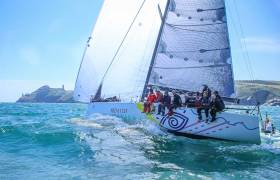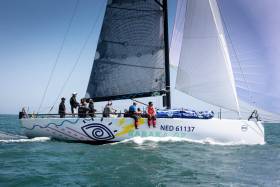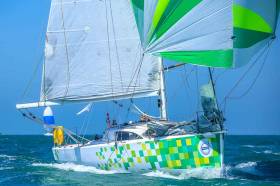Displaying items by tag: Round Ireland Yacht Race
Niall Dowling’s chartered Ker 43 Baraka GP was across the finish line at Wicklow a few minutes before 1.30pm to comfortably take line honours in the 2018 edition of the Volvo Round Ireland Yacht Race, the 20th staging of this major event.
The Royal Irish YC skipper has seen his specialised boat put in a spectacular performance during the past 18 hours, lengthening away from all opposition to such good effect that the next in line, the Volvo 60 Libertalia Team Jokolia, is still all of 90 miles from the finish.
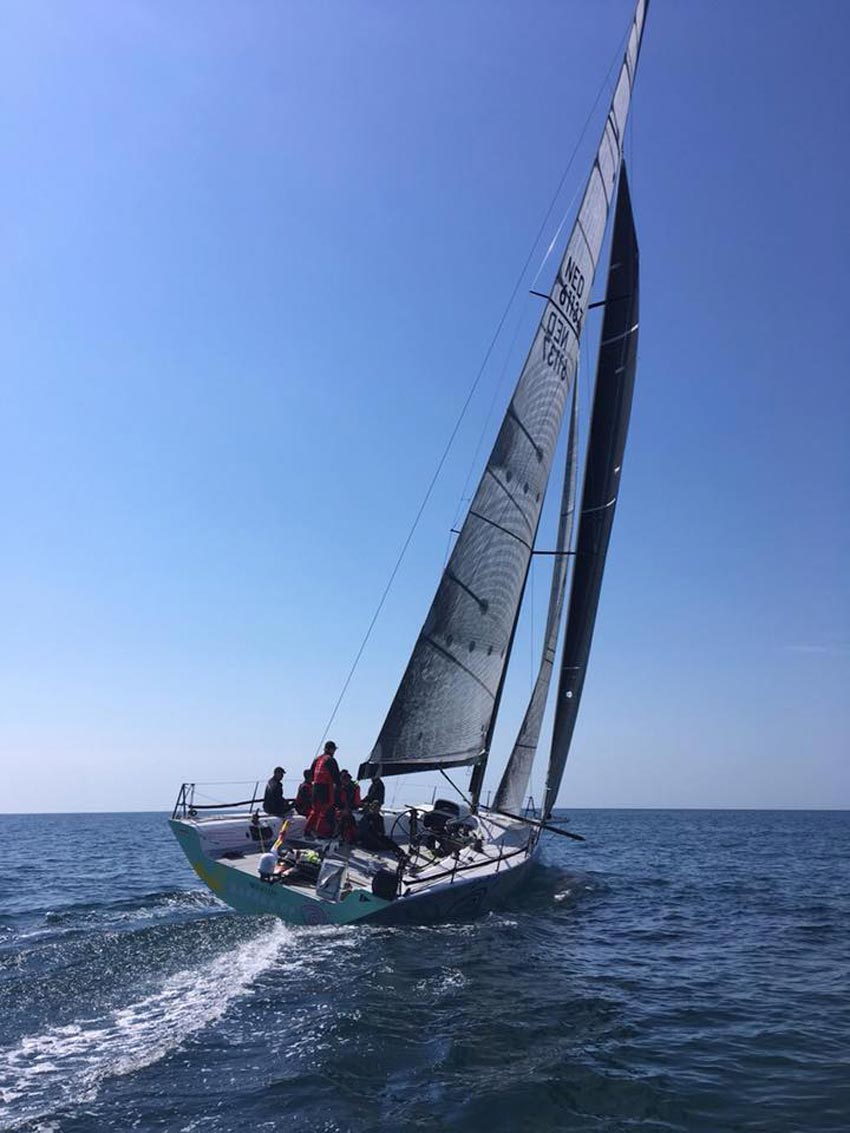 At the time of finish, Baraka was shown as having a Corrected Time lead of seven hours. Photo: John Sheehy/RStGYC
At the time of finish, Baraka was shown as having a Corrected Time lead of seven hours. Photo: John Sheehy/RStGYC
Baraka is indicated as currently having a strong lead in the main section of the fleet, the IRC Handicap Division. Her closest challenger, Chris Power Smith’s J/122 Aurelia, still has 140 miles to race, and at the time of finish, Baraka was shown as having a Corrected Time lead of seven hours.
Race tracker and leaderboard HERE
Afloat.ie Round Ireland updates in this one handy link HERE
Round Ireland Day 5. 10am: Leading Boat Baraka Gets Even More Businesslike in Final Stages
After Niall Dowling’s Ker 43 Baraka had led the Volvo Round Ireland fleet by a large margin in successfully negotiating the adverse tides of Rathlin Island yesterday evening, ace navigator Ian Moore (originally of Carrickfergus) had moved his boat and shipmates into an entirely different scenario from the scattered opposition astern – some of it very far astern writes W M Nixon.
Once onto the east coast, the fleet leader on the water and in IRC handicap found smoother water and breezes which gave her sufficient speed to make a nonsense of the foul tides. And as it became a fair tide well before midnight, she was soon streaking through the North Channel in the night like an arrow at 9 knots and then 10 knots, while the second-placed Aurelia (Chris Power-Smith) struggled with headwinds in those notably disturbed waters between the most northerly coasts and islands of Ireland, and the Scottish island of Islay.
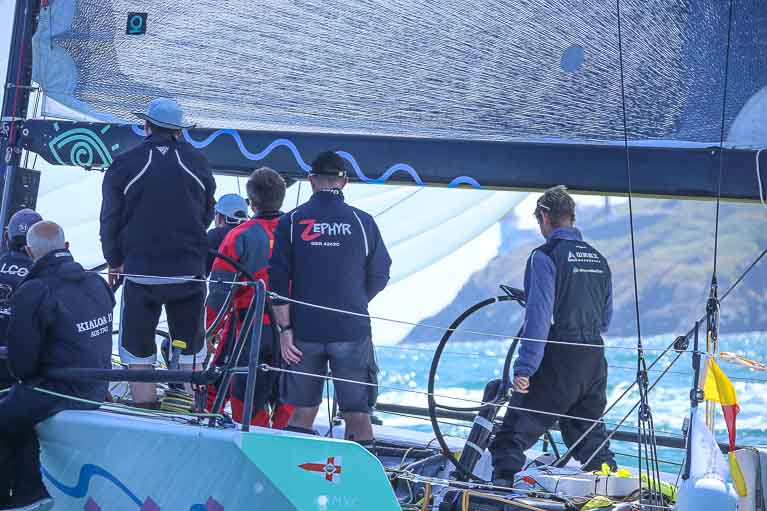 Fleet leader Baraka GP, the beautifully-prepared Ker 43 is crewed entirely by top sailing professionals Photo: Afloat.ie
Fleet leader Baraka GP, the beautifully-prepared Ker 43 is crewed entirely by top sailing professionals Photo: Afloat.ie
Baraka’s progress has been so good that she is now well past Rockabill, and making 8.8 knots towards the Wicklow finish just 28 miles away despite the first signs of the adverse north flowing tide as she gets into the waters of St George’s Channel. In the heat of recent days, it has been shown that the Greater Dublin area generates one of the briskest sea breezes in the country, so being becalmed in the final approaches towards the finish seems unlikely, and we could be looking at an early afternoon finish.
"Overall, the picture is not so encouraging for the rest of the fleet"
Overall, the picture is not so encouraging for the rest of the fleet, as the winds off Donegal are all over the place, but in the overnight re-shuffle of the pack, Ian Hickeys Noray 38 Cavatina from Cork – winner of two previous circuits when lower-rated boats were favoured – is now up into second overall, but she is currently almost becalmed five miles westward of Bloody Foreland in Donegal, So even though there may be nor’westers tomorrow, at the moment it requires infinite faith and patience to keep Cavatina in the hunt. But her crew have shown they have these traits in abundance, and if this race has shown anything, it is that fortunes can suddenly improve out of all recognition.
 Paul O’Higgins’ JPK 10.80 Rockabill VI Photo: Afloat.ie
Paul O’Higgins’ JPK 10.80 Rockabill VI Photo: Afloat.ie
One boat which seems determined to prove this is Paul O’Higgins’ JPK 10.80 Rockabill VI. Yesterday morning at 1100 hrs, she and Chris Power Smith’s Aurelia were on the wind in close proximity to each other, on starboard tack about eight miles off Rossan Point at the most rugged area of the Donegal coast. Then for the first time in many miles, they split. Aurelia continued to head north, but Rockabill took a stab in towards the shore.
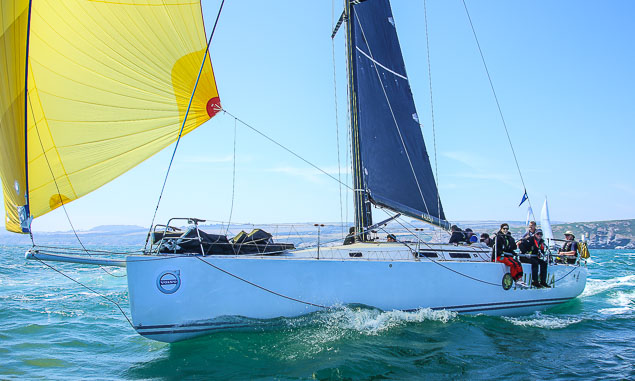 Chris Power Smith’s J122 Aurelia Photo: Afloat.ie
Chris Power Smith’s J122 Aurelia Photo: Afloat.ie
It was a fatal error. For much of the day, she was virtually becalmed off Loughros More Bay, while Aurelia sailed merrily along in a private breeze, beating efficiently past Bloody Foreland and Tory Island and doing so well that at times she was showing as leader overall on IRC.
But having finally found a breeze again, Rockabill VI is now on the attack, and is currently approaching Malin Head – admittedly at just 5.6 knots – with the tide soon to turn in her favour. Aurelia meanwhile has been doing some rather desperate tacking against the foul tide well out at sea, midway between the entrance to Lough Foyle and the southwest coast of Islay, and equally anticipating the favourable turn of the tide with hope.
But it is inevitably all rather messy by comparison with the clinical performance which has been put in during the past 24 hours by Baraka GP. Admittedly the beautifully-prepared Ker 43 is crewed entirely by top professionals. But when we remember that 36 hours ago she was shown as being back in 24th place in IRC overall, it’s fascinating to see what real pros can do when they seem to have been dealt a very challenging hand.
"Baraka GP has a clear lead on Corrected Time of seven hours over second-placed Cavatina"
By this afternoon, they’ll be in the Wicklow waiting game. But for now, as she sweeps past Lambay in a very sunny easterly breeze at 8.6 knots over the ground, Baraka GP has a clear lead on Corrected Time of seven hours over second-placed Cavatina.
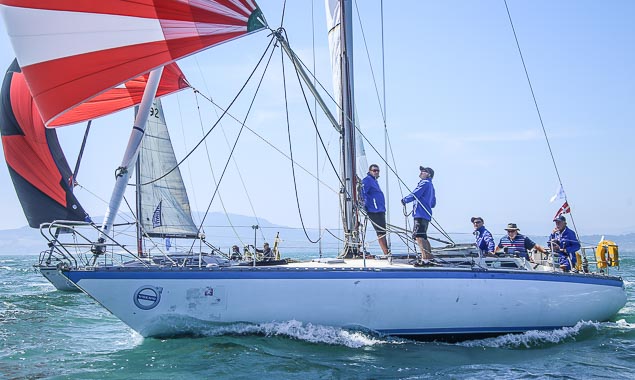 Cork yacht Cavatina, a double race winner, is lying in second place Photo: Afloat.ie
Cork yacht Cavatina, a double race winner, is lying in second place Photo: Afloat.ie
Third is the Swan 44 CoOperation Ireland (Paul Kavanagh), 4th is the JPK 10.10 Jaasap (Nicolas Pasternak), which like the Kavanagh boat, is being sailed two-handed, fifth is Aurelia and sixth is the Barry Byrne-skippered J/109 Joker II.
 Defence forces entry Joker II skippered by Commandant Barry Byrne Photo: Afloat.ie
Defence forces entry Joker II skippered by Commandant Barry Byrne Photo: Afloat.ie
But while there’s less than two hours’ difference between the corrected times of Cavatina and Joker II, Baraka GP has that very clear seven-hour margin. Now, approaching the finish, she is indeed very much in a race of her own.
Race tracker and leaderboard HERE
Afloat.ie Round Ireland updates in this one handy link HERE
Three years ago, after he’d navigated a Transatlantic Race winner to a mighty victory, his crewmates said admiringly of Ian Moore that having him aboard as navigator/tactician was as good as narrowing the ocean by at least 150 miles and probably much more writes W M Nixon
This evening, Moore has been giving a master-class in working every little twist of the coast to get the Ker 43 Baraka GP (Niall Dowling) past tide-riven Rathlin Island against both tide and wind. It’s very different from weather-reading skills in mid-ocean, but it’s all part of the multi-faceted Moore package.
 Baraka GP Navigator Ian Moore (left) and Skipper Niall Dowling Photo: Afloat.ie
Baraka GP Navigator Ian Moore (left) and Skipper Niall Dowling Photo: Afloat.ie
Having taken the boat in towards the scenic Antrim coast to minimise the adverse effects of the full flowing ebb, he has been cliff-hopping along Rathlin’s steep north side after closing up with the island in its tidal shadow.
 In the overall race handicap stakes, Pasternak Nicolas on Jaasap, a JPK 1010 tops the provisional leader-board, taking over from Stephen Quinn's J97 Lambay Rules (below) Photos: Afloat.ie
In the overall race handicap stakes, Pasternak Nicolas on Jaasap, a JPK 1010 tops the provisional leader-board, taking over from Stephen Quinn's J97 Lambay Rules (below) Photos: Afloat.ie
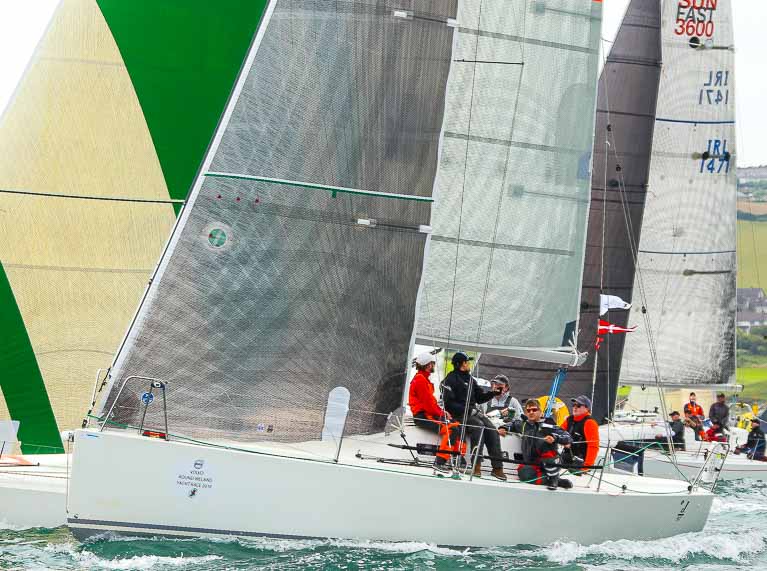
This is one odd island. You begin to realise that you’ve arrived at a crazy place when you notice that while the clifftop Rathlin West lighthouse may have an orthodox white tower, the actual light which should be that the top is at the base, sitting beside it, in order to keep it below the fog ceiling…….There’s the photo above to prove it.
"It’s still very much Game On, promising an interesting night of boat racing"
And as for Ian Moore’s tide-dodging, the ploy is working so well that Baraka has continued to improve her overall standing in the IRC fleet, going up from 6th to 4th and now first as the smaller challengers are slowed by plugging to windward in lumpy seas back off Donegal.
The off-the-wall Rathlin scenario - it’s something with which every persistent round Ireland competitor can readily identify. Years ago, this reporter found himself doing the circuit on a ramshackle 83ft Maxi well stricken in years, with sails to match. There were loose bits hanging out of the huge mainsail. It looked like anything but a racing mainsail. We were forcefully reminded of this as we dodged the foul tide right in under the Rathlin rock-face, and cliff-nesting seabirds tried to alight on our mainsail under the impression it was their multi-ledged home. I am not making this up.
Nor am I making up the fact that Baraka and her multi-talented crew are sailing a blinder. We hinted at the possibility yesterday of such a thing eventually arising, but didn’t expect to see it so soon, demonstrated quite so vividly and in this Rathlin place too – we were looking instead for an unexpectedly fast Irish Sea transit.
There’s still plenty of time for the Niall Dowling-skippered boat to get hung up by evening calm and the remains of the ebb past Fair Head. But the tide turns again by around 10.0pm, and we can be quite sure that Ian Moore will know of the local spots where it turns earlier – in some cases much earlier - and will make sure Baraka is right there if at all possible.
As it is, with Baraka close in – and we mean really close in - at Rathlin’s northeast corner at 6.30 pm and still somehow making good at all of 7 knots, all bets were off. Because she is now calculated as leading IRC overall on Corrected Time. Which shouldn’t be the case at all, but there it is, and though by 7.0pm she was slowed back to 5.0 knots over the ground, she’d broken through the Rathlin tidal gate and was round the corner and on her way.
 Chris Power Smith's J122 Aurelia is up to fourth overall Photo: Afloat.ie
Chris Power Smith's J122 Aurelia is up to fourth overall Photo: Afloat.ie
On down the line, the big news is that Chris Power Smith’s J/122 Aurelia has got her mojo back. With the Prof on board in fine form, Aurelia took a little private stab to seaward out west of Glencolmcille in Donegal, found herself a better breeze, and now she’s up to fourth overall, but still half an hour behind the miraculous Baraka. However, with the top six boats covering less than an hour, it’s still very much Game On, promising an interesting night of boat racing.
 Rónán O'Siochrú's team on Irish Offshore Sailing's Desert Star, have overcome a spell of seasickness for some crew-members Photo: Afloat.ie
Rónán O'Siochrú's team on Irish Offshore Sailing's Desert Star, have overcome a spell of seasickness for some crew-members Photo: Afloat.ie
Race tracker and leaderboard HERE
Afloat.ie Round Ireland updates in this one handy link HERE
When they left the tide-swept Tuskar Rock astern on Saturday night with a cold fair wind helping them on their way, the crews in the Volvo Round Ireland 2018 knew that tidal streams would no longer play a hugely significant role in the race until they’d got to Ireland’s most northerly point at Malin Head writes W M Nixon.
But between Malin Head with its turning mark out beyond the rocks of Inishtrahull off northern Donegal, and the South Rock off County Down’s east coast, tide is the dominant factor. It can run at up to 8 knots around Rathlin Island and off Fair Head, and there’s an entire universe of difference between having it in your favour and being agin it.
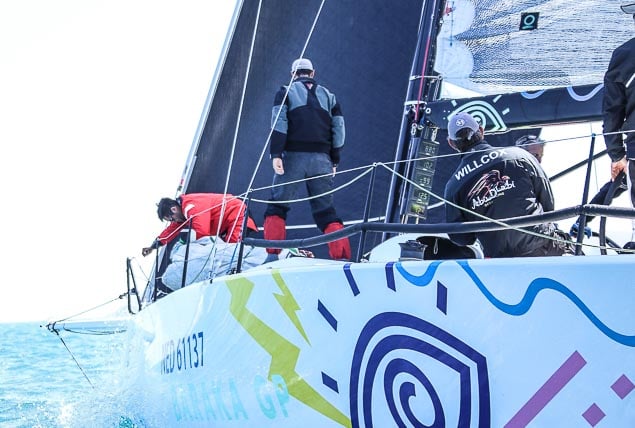 Niall Dowling's Baraka GP Photo: Afloat.ie
Niall Dowling's Baraka GP Photo: Afloat.ie
For fleet leader Baraka GP (Niall Dowling, RIYC), this is all about to become painfully evident. Her crew will have hoped to be at Malin Head in time for the new east going flood around 1030 this morning, and it looked for a while as if they might be on time. But a soft patch north of Lough Swilly found them well off the pace, and by the time they got to Inishtrahull, half of the favourable six-hour flood had already run its course.
"Everything enters a new chapter with those North Channel tides playing an increasing role in the story"
So although she’s off the mouth of Lough Foyle making a crisp 9 knots and better as we write this, by 1600 hrs the fates will be against Baraka. She’ll have six hours of frustration which will test her crew as they work to find any favourable eddy that’s going, which they can only do if the northeast breeze holds up.
 JPK 10.80 Rockabill VI (Paul O’Higgins) has moved up to fourth overall on IRC Photo: Afloat.ie
JPK 10.80 Rockabill VI (Paul O’Higgins) has moved up to fourth overall on IRC Photo: Afloat.ie
Overall, things had been looking much better for the impressive Ker 43, as she’d continued her upward progress in the IRC overall stakes to have reached 7th place. Well astern, the rest of the IRC fleet continues to turn to windward off North Mayo and Donegal coasts, with the JPK 10.80 Rockabill VI (Paul O’Higgins) and the J/122 Aurelia (Chris Power Smith) showing impressive gains to move up to 4th and 5th overall.
 J/122 Aurelia (Chris Power Smith) now in fifth on IRC overall Photo: Afloat.ie
J/122 Aurelia (Chris Power Smith) now in fifth on IRC overall Photo: Afloat.ie
Paul Kavanagh’s handsome Swan 44 CoOperation Ireland continues to lead overall, with Stephen Quinn’s J/97 Lambay Rules just 5 minutes astern in second. Barry Byrne continues well in control of all the J/109s, his Joker II lies 5th overall, but Ian Hickey’s gallant old Noray 38 Cavatina has slipped a bit - she’s now back in 8th.
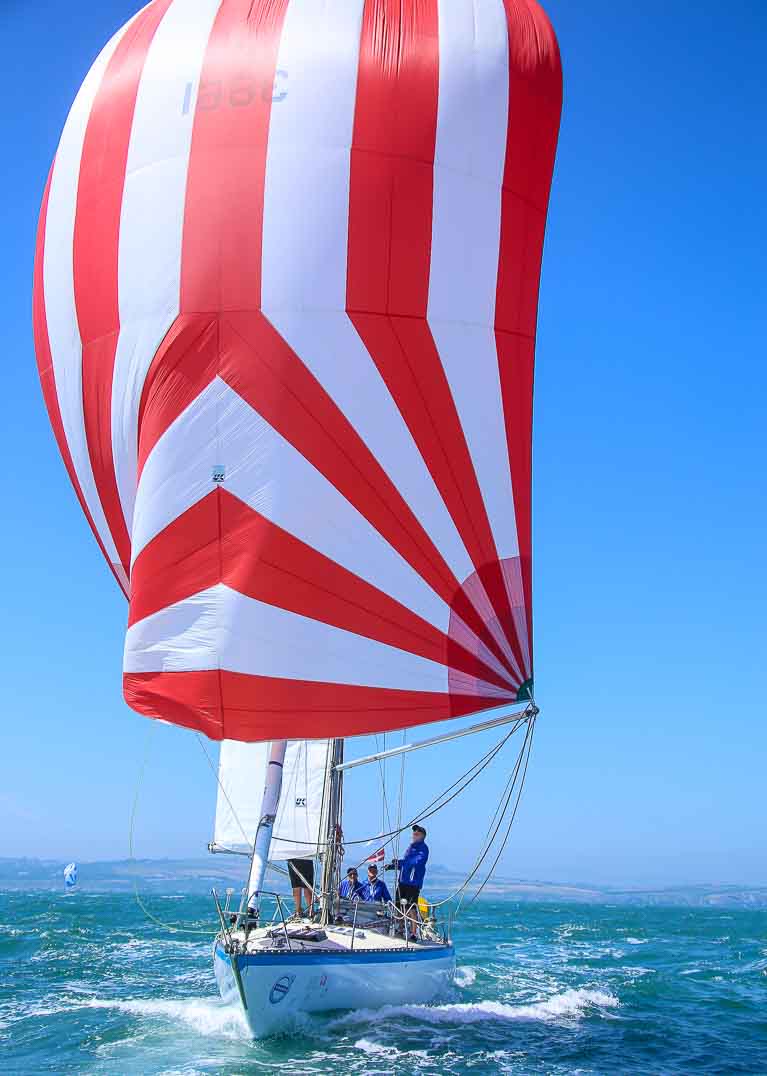 Ian Hickey’s Noray 38 Cavatina has slipped to eighth. Now in her 40th year the Cork crew is hoping for a third race win in the vintage yacht. Photo: Afloat.ie
Ian Hickey’s Noray 38 Cavatina has slipped to eighth. Now in her 40th year the Cork crew is hoping for a third race win in the vintage yacht. Photo: Afloat.ie
However, everything enters a new chapter with those North Channel tides playing an increasing role in the story, and we’ll see how it has shaken things up with the 7.0pm posting.
Race tracker and leaderboard HERE
Afloat.ie Round Ireland updates in this one handy link HERE
Round Ireland Day 4. 10am. Headwinds Ease But Tides Will Soon Take Centre Stage for Leader
The vigorous north to northeast winds which have given the fleet in the Volvo Round Ireland Race 2018 such a tough time as they battled their way up the Atlantic seaboard have now eased and veered further as the leaders work their way around the coast of Donegal and northwest Mayo writes W M Nixon.
This means the north coast is now providing line honours leader Baraka GP (Ker 43, Niall Dowling RIYC) with yet another dead beat. And the further east she gets, the more significant becomes the role of the tides, with the new flood tide eastward into the North Channel now flowing strongly from Malin Head towards Rathlin.
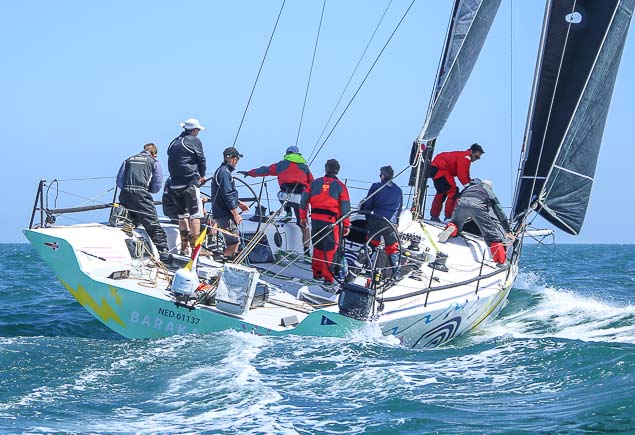 Niall Dowling's Baraka GP is line honours leader Photo: Afloat.ie
Niall Dowling's Baraka GP is line honours leader Photo: Afloat.ie
When you’re beating, a favourable tide is a mixed blessing, for even in lighter winds it quickly kicks up a steep and breaking sea. But Baraka GP has shown her exceptional ability to maintain high average speeds in a wide variety of adverse sea states, and as predicted last night, she is expected to continue to improve her overall position, which has now moved up from 16th to 11th overall this morning - a significant improvement on the 24th place she was recording 24 hours ago.
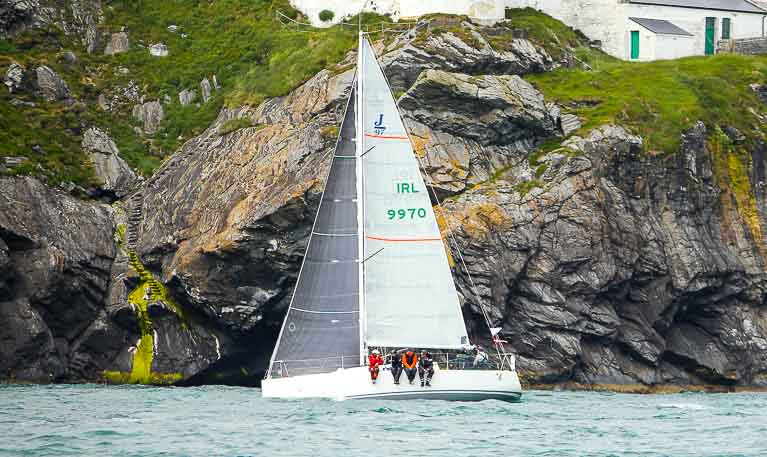 Stephen Quinn's J97 Lambay Rules Photo: Afloat.ie
Stephen Quinn's J97 Lambay Rules Photo: Afloat.ie
The IRC Corrected Time lead has seen a slight shift, with Paul Kavanagh’s classic 45-year-old Swan 44 CoOperation Ireland now narrowly ahead (the gap is just three minutes) of Stephen Quinn’s little J/97 Lambay Rules. The main consideration here is that the Kavanagh boat is being raced in the two-handed division, which makes her current placing a great achievement, even if the long tough beat all the way from the Skelligs in Kerry and beyond has been the sort of sailing the Swans of that vintage particularly relish.
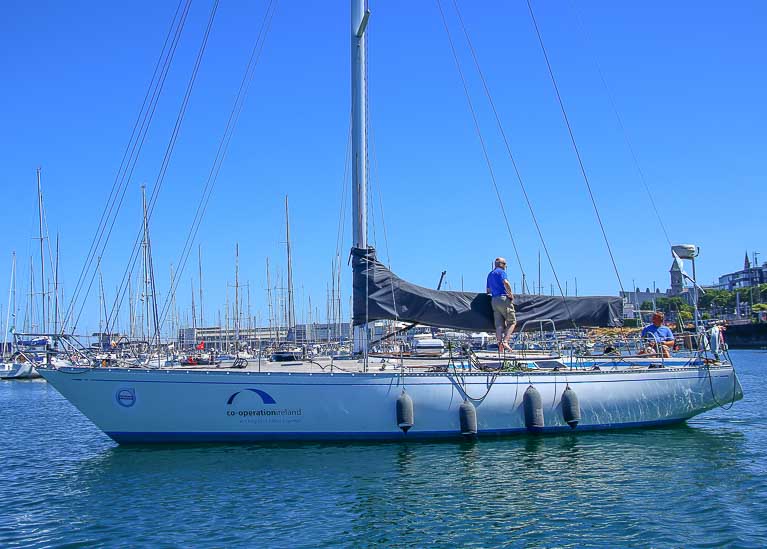 Paul Kavanagh’s classic 45-year-old Swan 44 Co–Operation North is a two-handed Round Ireland entry Photo: Afloat.ie
Paul Kavanagh’s classic 45-year-old Swan 44 Co–Operation North is a two-handed Round Ireland entry Photo: Afloat.ie
 First Lieutenant Alexander Rumball from the Artillery Corps is a helmsman on the Joker II Defence Forces entry and this morning leads his brother Kenny on the J109 sistership, Jedi (below) in some Round Ireland family rivalry Photo: Afloat.ie
First Lieutenant Alexander Rumball from the Artillery Corps is a helmsman on the Joker II Defence Forces entry and this morning leads his brother Kenny on the J109 sistership, Jedi (below) in some Round Ireland family rivalry Photo: Afloat.ie
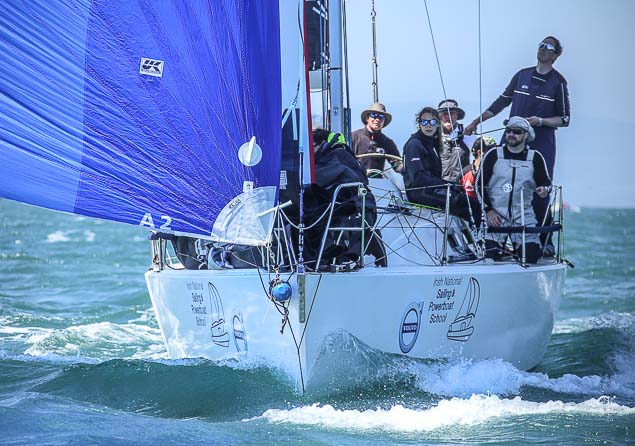
Other overnight expectations have been fulfilled, with the J/109 Joker II (currently off Broadhaven in Mayo) continuing to be raced with style by Barry Byrne and navigator Mick Liddy. Having surprised everyone yesterday by a massive flyer far west into the Atlantic which did them no harm at all, they now lie fourth overall, close behind the third-placed French JPK 10.10 Jaasap (Nicolas Pasternak).
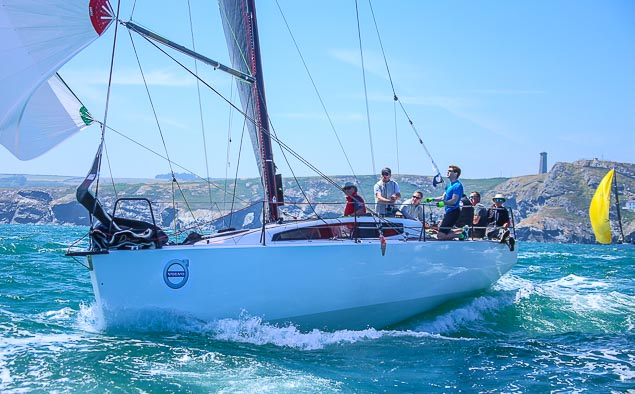 Paul O’Higgins’ JPK 10.80 Rockabill VI from the Royal Irish Yacht Club Photo: Afloat.ie
Paul O’Higgins’ JPK 10.80 Rockabill VI from the Royal Irish Yacht Club Photo: Afloat.ie
As for the two of the pre-race Irish favourites, Paul O’Higgins’ JPK 10.80 Rockabill VI and Chris Power Smith’s J/122 Aurelia, they too have fulfilled expectations of overnight improvement with Rockabill VI now up in 5th overall and going well midway across Donegal Bay between Broadhaven and Rathlin O’Beirne, while Aurelia is close by, and significantly moved up the rankings from 18th overall to 9th.
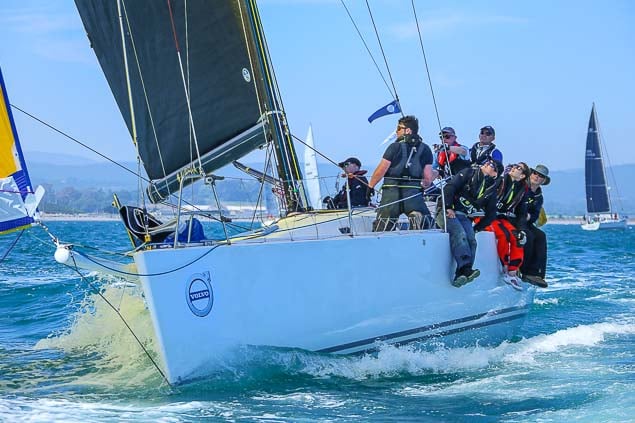 Chris Power Smith’s J/122 Aurelia from the Royal St. George Yacht Club Photo: Afloat.ie
Chris Power Smith’s J/122 Aurelia from the Royal St. George Yacht Club Photo: Afloat.ie
The fleet is now well spread at its extremities, with Baraka GP far to the furthest north approaching Malin Head, while the oldest boat in the fleet, the 81-year-old restored 43ft classic gaff ketch Maybird (Darryl Hughes) is still off Kerry, having recently experienced much lighter winds than those being “enjoyed” by the bulk of the fleet west of Clare and Connacht.
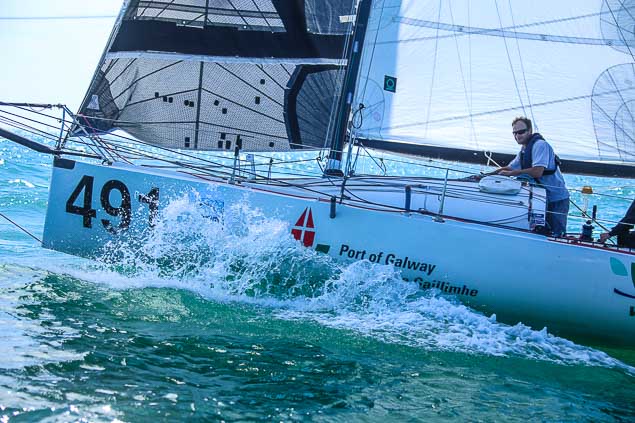 Mini 650 Port of Galway (Yannick Lemonnier) Photo: Afloat.ie
Mini 650 Port of Galway (Yannick Lemonnier) Photo: Afloat.ie
The two litle’uns, the Mini 650s Port of Galway (Yannick Lemonnier) and 303 Blackshell Farm, are still in the hunt with Blackshell (Louis Mulloy) off Clifden making 3.9 knots in the gentler wind, while Port of Galway is at a brisker 5.9 knots off Clew Bay.
Race tracker and leaderboard HERE
Afloat.ie Round Ireland updates in this one handy link HERE
Round Ireland Day 3. 7pm: Making Sense Of Racing On The Wild Atlantic Way Is Explaining The Inexplicable
If you wanted an object lesson in why it is sometimes very difficult to explain sailing – and particularly offshore racing – to some goodwill-filled stranger to the sport, then the current state of play in the Volvo Round Ireland Race is as good as you’ll get, writes W M Nixon.
For the news is that, as far as current placings are concerned, the fleet has closed up. Yet even the most casual glance at the Tracker Chart reveals they’re all over the place.
Somewhere off the north coast of far Mayo is the fleet leader Baraka GP. To the south, off the coast of Galway, is the J/109 Joker II, driven on by the formidable talents of skipper Barry Byrne and Mick Liddy as navigator, and she has been away out on her own to the west.
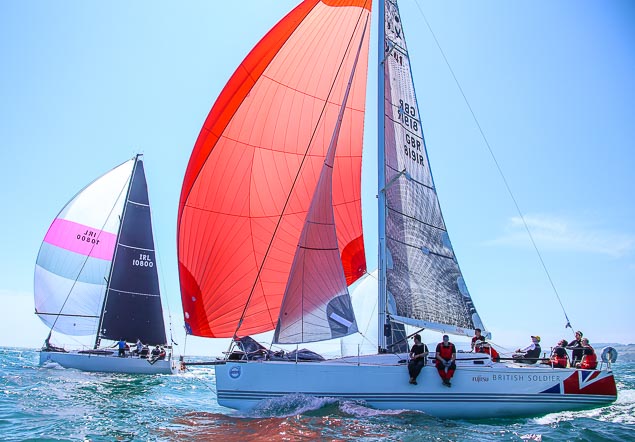 Futisu/British Soldier to weather and Rockabill VI on the reach down the Wicklow coast on Saturday Photo: Afloat.ie
Futisu/British Soldier to weather and Rockabill VI on the reach down the Wicklow coast on Saturday Photo: Afloat.ie
Yet close inshore off Clifden are three boats short tacking against each other, notably including Aurelia with The Prof on board, and Rockabill VI with Mono on the strength, which makes this definitely a battle to watch.
Then, spread out over a wide swathe of ocean to the southwest and south of them, are boats apparently heading every which way, and making no sense at all to the casual observer. Yet tracker addicts click a button or two, look at a heap of lists and figures, and sagely observe: “Ah yes, the fleet has been closing up...”
It’s the wonders of Corrected Time at work. Corrected Time sounds like something with which only the likes of Einstein or Hawking should be grappling. Yet your roughest toughest, saltiest, scantily educated offshore sailor can take it in his stride without for a moment realizing that the whole thing sounds utterly crazy to everyone else.
Anyway with this seventh update – and God help us, but they’re only halfway round – we’ll assume you’ve been following the story so far, and we’ll take it from there.
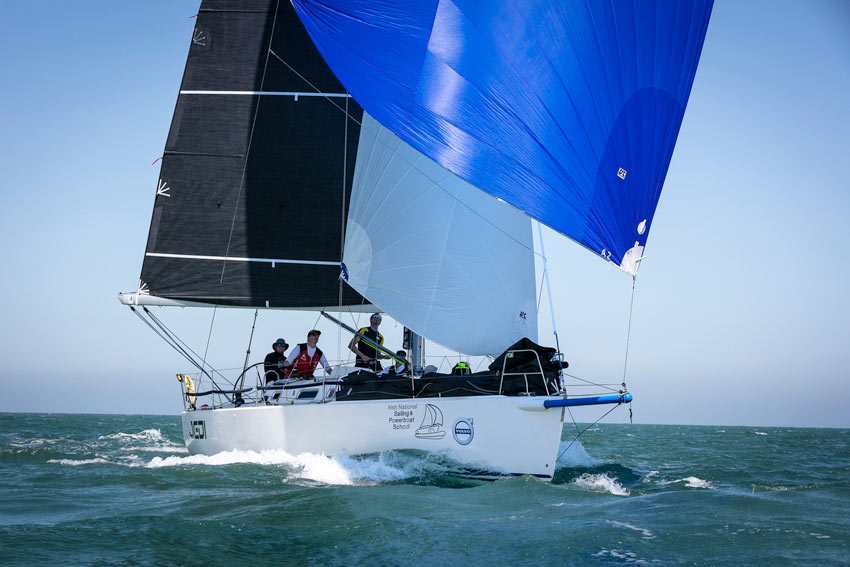 Former race winner Michael Boyd on Jedi reported a Man Overboard who was “immediately and efficiently” recovered. Photo: David Branigan
Former race winner Michael Boyd on Jedi reported a Man Overboard who was “immediately and efficiently” recovered. Photo: David Branigan
Just as was gloomily predicted, when Niall Dowling’s leader on the water, the very zippy Ker 43 Baraka GP, got up to the Mayo turning point at Eagle Island at 4pm this afternoon, sure enough the wind veered to arrange that she had yet another dead beat, this time to Tory Island off Donegal, beyond Bloody Foreland – or Utterly Bloody Foreland, as it’s known to old Round Ireland hands.
Meanwhile, down off the coast of Connemara, the other big beasts on Aurelia and Rockabill found themselves drawn into a short-tacking duel around Slyne Head, a singularly rocky place with lumpy seas and more lobster pot lines in the area than you’d know what to do with. But they’ve managed to keep themselves clear and continued along that lovely coast, slugging to windward every inch of the way in a persistent north to northeast breeze.
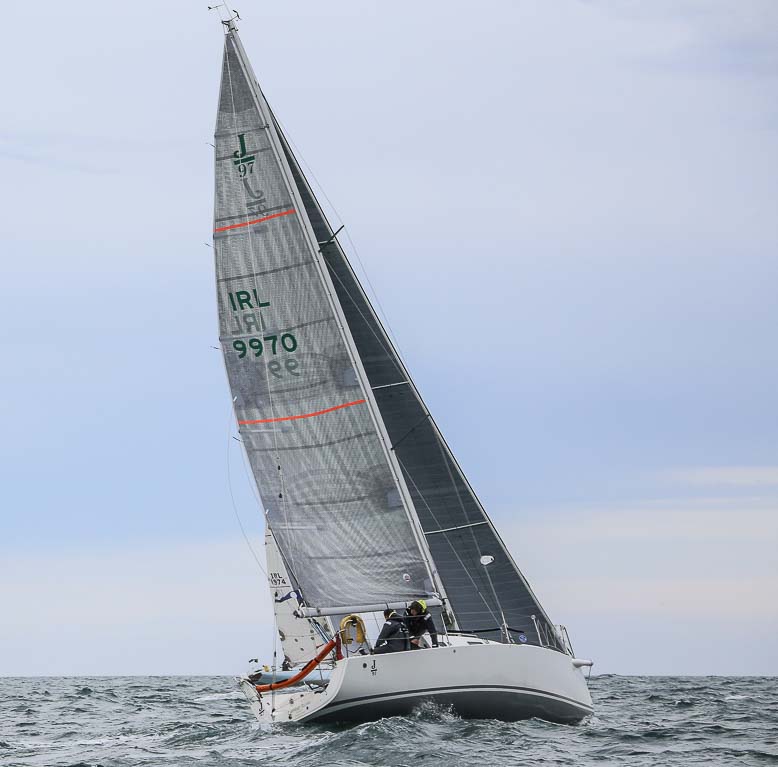 Howth Yacht Club's Lambay Rules still leads Photo: Afloat.ie
Howth Yacht Club's Lambay Rules still leads Photo: Afloat.ie
So in order to make sense of it all, we resort to the IRC Overall Leaderboard, and see that according to calculations issuing from some secret headquarters in some bunker somewhere, Stephen Quinn’s gallant little J/97 Lambay Rules from Howth is still first, while Nicolas Pasternak’s JPK 10.10 Jaasap from France is second (which is quite something, as she is being sailed two-handed).
Ian Hickey’s veteran Cavatina from Cork continues in third, another two-hander, the classic Swan 44 CoOperation Ireland (Paul Kavanagh) is fourth, then another JPK 10.10, Jangada, this time from England (Richard Palmer) is fifth, and the French-based Sunfast 3200 SNSP Hakuna Matata (don’t ask) is sixth.
Yet there are now just two hours between Lambay Rules and SNSP Hakuna Matata. It’s a time gap which can disappear in a flash with a slight switch in wind strength and direction, and it explains why the pundits have been talking about the fleet closing up.
But closed up or opening out, the reality is that tonight there’s much windward work to be done.
And with the reversals of fortune which are the way with this unusual edition of an already highly individual race, we might well see Rockabill VI move up from her current placing of eighth overall, and Joker II improve from 10th, while for Aurelia at 18th, the only way is up.
That such improvements are possible is being demonstrated by Niall Dowling and his highly-qualified crew in Baraka GP. Everything has seemed to be stacked against them in terms of wind patterns. Yet they’ve kept at it with the highest level of dedication, and despite endless windward work, they’ve climbed up from 24th overall to their present placing of 16th.
Given the slightest chance, perhaps just let there be the slightest swing of the weather in their favour, and we could be looking at an extraordinary outcome off the Wicklow pierheads on Wednesday.
As for the unluckier competitors, several boats have been forced out of the race, mostly due to gear failure in the testing conditions, while one boat retired for a precautionary medical check for a crew-member who received a minor shoulder injury after a fall on board.
Early this morning, former race winner Michael Boyd on Jedi reported a Man Overboard who was “immediately and efficiently” recovered on board. The Irish Coast Guard was informed but no further action was required and the team is continuing with the race.
Race tracker HERE
Afloat.ie Round Ireland updates in this one handy link HERE.
Round Ireland Day 3. 2.30pm. Fleet in Long Haul Northwards Along the Wild Atlantic Way
It’s big country out west writes W M Nixon. And big country can have big effects on summer winds. So although the main part of the Volvo Round Ireland 2018 fleet is plugging doggedly along to windward out in the Atlantic in north to northeast winds of varying strengths, they know that if they try their luck too close inshore, their reasonably reliable breeze might evaporate.
On the other hand, they might find a locally favourable breeze. As an example, the lonely weather station at Mace Head just eastward of Slyne Head is currently indicating a westerly of 9 mph. But all around, the basic wind – now sparse enough in places – is north to northeast. The fleet has to sail with that, regardless of how pleasant gentle northward progress might be, reaching in an imaginary westerly breeze.
The reality is that the “real” wind is very much on the nose, but it has to be said that some of the slicker boats can achieve astonishing upwind speeds. We’d a remarkable example of this yesterday (Sunday) evening when Niall Dowling’s Ker 43 Baraka was slogging nor’eastwards north of the Blaskets on port tack in plenty of wind and then some, and she was making 9.1 knots.
If you’ve ever sailed in and around the Blaskets when there’s a bit of a breeze about, you’ll know that the sea state can be compared to very lumpy porridge. And it’s often the same colour too, though things are different in the colour stakes at the moment. But, be that as it may, there was Baraka, slugging along in conditions in which many boats would be glad enough to make any windward progress at all, yet the Ker 43 was slicing along at a very businesslike 9.1 knots. Astonishing stuff.
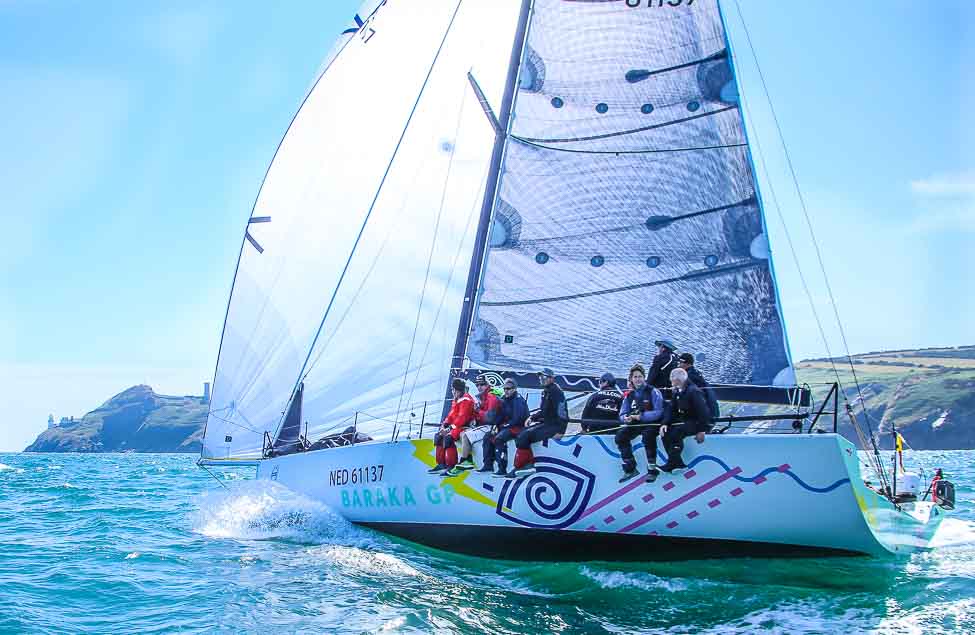 Niall Dowling's Bakara GP Photo: Afloat.ie
Niall Dowling's Bakara GP Photo: Afloat.ie
For now at 2.0pm Monday - after tacking in and out of some of the Wild Atlantic Way’s most spectacular features – Baraka is well past Achill Head at 8.7 knots and has tacked in towards the Inishkea Islands. While she may be 24th overall on IRC, in terms of line honours she’s increasingly in a race of her own with more than half the course now sailed, as the closest contender for first-to-finish, the Mach 40 Corum, is still south of Achill and sailing on starboard, having tacked close west of Clare Island.
 Howth's Conor Fogerty is onboard with Susan Glenny on the First 40 schoolship Olympia’s Tigress Photo: Afloat.ie
Howth's Conor Fogerty is onboard with Susan Glenny on the First 40 schoolship Olympia’s Tigress Photo: Afloat.ie
To seaward beyond Slyne Head, we find most of the fleet with marked differences of opinion as to how best to play this tricky beat. “Sailor of the Year” Conor Fogerty with Susan Glenny on the First 40 schoolship Olympia’s Tigress had been seeking the stronger winds supposedly to the west, but now they’ve come in on port tack to find themselves ahead of Michael Boyd in the J.109 Jedi, but astern of Barry Byrne with the leading J/109 Joker II, which lies fifth overall in IRC.
IRC overall leader Lambay Rules (J/97, Stephen Quinn) has continued to sail conservatively in the middle of the fleet which is centred slightly west of the rhumb line, for although the best winds in the night were well to the east towards County Clare, for a while today there was more breeze to the west out at sea.
"both racing in the two-handed division, a wonderful achievement even if they are allowed to use the autohelm"
Ian Hickey’s veteran Noray 38 Cavatina is really loving it, and has moved up to second overall. Like Lambay Rules, she’s taking a conservative middle route. However, it’s the boats which are third and fourth overall which deserve added attention, for the JPK 10.10 Jaasap and the classic Swan 44 CoOperation Ireland (Paul Kavanagh) are both racing in the two-handed division, a wonderful achievement even if they are allowed to use the autohelm.
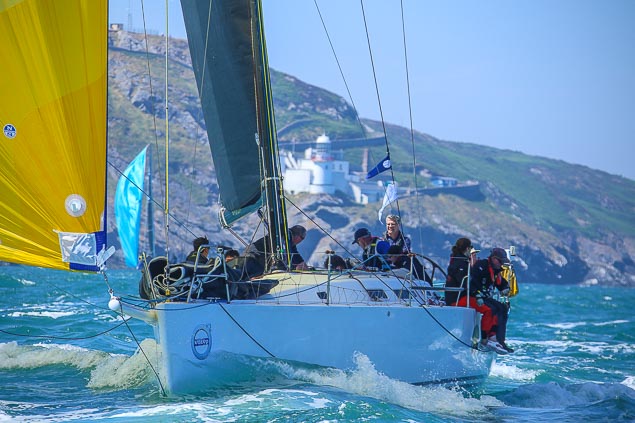 Glued together – Aurelia (above) and Rockabill VI (below) are neck and neck Photo: Afloat.ie
Glued together – Aurelia (above) and Rockabill VI (below) are neck and neck Photo: Afloat.ie

As to other pre-race favourites, it’s as though Chris Power Smith’s J/122 Aurelia (with The Prof on board), and Paul O’Higgins’ JPK 10.80 Rockabill VI (Mark Mansfield is on the strength) have become glued together. They seem inseparable over on the east side of the fleet, both of them taking a temporarily useful slant on port tack towards Ballyconneely, and neck-and-neck with it.
However, Rockabill lies 8th overall on IRC, albeit it more than two hours behind Lambay Rules on projected elapsed time, while the higher-rated Aurelia is projected as six hours astray. But as we well know, projected times and real times may be reduced to a very tenuous relationship by the time the finishing line is reached.
Race tracker here
Afloat.ie Round Ireland updates in this one handy link here.
The IRC overall lead is being tightly contested this morning in the Volvo Round Ireland race 2018 with the bulk of the fleet now to the west of County Clare, slugging to windward in a north to northeast breeze writes W M Nixon. The coveted lead position in IRC overall is being very hard-fought, and it frequently changes hands.
But at 0900hrs the top four saw Stephen Quinn’s J/97 Lambay Rules from Howth Yacht Club leading by just 15 minutes from Ian Hickey’s Noray 38 Cavatina from Cork, with the French JPK 10.10 Jaasap third and the J/109 Joker II skippered by Commandant Barry Byrne in fourth.
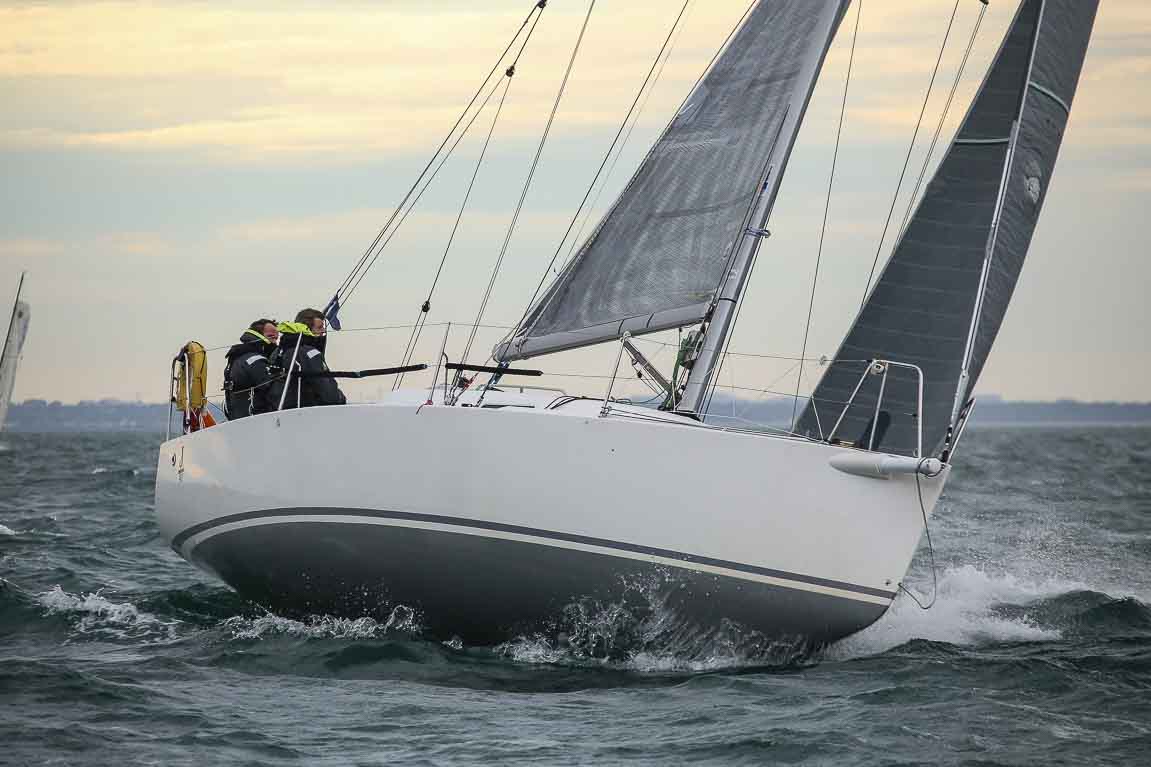 Stephen Quinn's J/97 Lambay Rules from Howth Yacht Club in two-handed mode for last year's D2D Race and (below) her current position off the County Clare coast at the head of the IRC Round Ireland fleet below Photo: Afloat.ie
Stephen Quinn's J/97 Lambay Rules from Howth Yacht Club in two-handed mode for last year's D2D Race and (below) her current position off the County Clare coast at the head of the IRC Round Ireland fleet below Photo: Afloat.ie
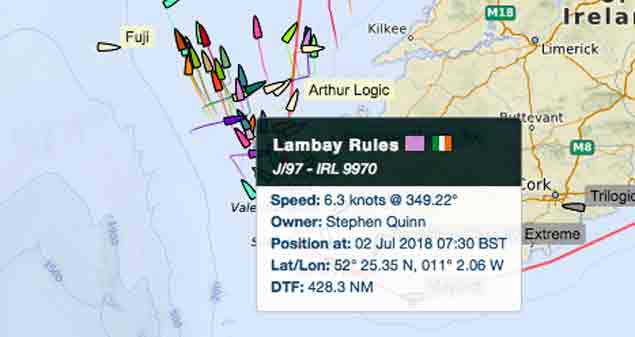
 J/109 Joker II skippered by Commandant Barry Byrne is fourth Photo: Afloat.ie
J/109 Joker II skippered by Commandant Barry Byrne is fourth Photo: Afloat.ie
The emergence of Cavatina among the front-runners for the first time is an inevitable consequence of the fact that yesterday off the Kerry coast from Dursey Head northwards, the leaders were bashing to windward while significantly lower-rated boats like Cavatina further astern were still sailing fast and on course in favourable conditions. But although Cavatina is now herself making to windward just north of the Blaskets, she has found a more favourable slant, whereas the bigger overall leaders on the water spent the night making the best of the hand they’d been dealt with, which was a beat to Slyne Head in Galway.
As was expected here yesterday, the front-runners tended to keep to the east of the course. In fact, the line honours contenders Baraka GP (Niall Dowling) and the new Mach 40 Corum came right in on port tack very close on Kerry Head, at the southwest side of the Mouth of the Shannon, before making serious northing up past Loop Head and then the Aran Islands.
 Ian Moore, Navigator on Baraka GP Photo: Afloat.ie
Ian Moore, Navigator on Baraka GP Photo: Afloat.ie
Navigator/tactician Ian Moore on Baraka was so certain that this was the way to go that he threw a couple of short port tacks to the westward of Inishmore in order to keep well eastward into the favoured waters in the approaches to Galway Bay.
At one stage Corum seemed to have got clear in front, but Baraka found a course that brought her in nicely on track and in front at Slyne Head while still hard on the wind. Along the Galway coast, she has been lengthening away, and with the wind off Connacht in the north and less certain of itself, she is currently laying past Inishbofin on port tack at 6.1 knots, leader on the water but 24th on IRC, with Corum a good nine miles astern.
"the emergence of Cavatina among the leaders has changed the shape of the game"
With the more marked easterly slant to the wind further back, the main part of the fleet has allowed themselves to get west of the track in anticipation of further veering of the wind. But it could well be that those who have made an effort to keep themselves more to the east - such as Paul O’Higgin’s Rockabill VI - could ultimately find it paying off.
Meanwhile the emergence of Cavatina among the leaders, somewhat earlier than had been expected, has changed the shape of the game. Today’s developments – where every gain will be down to very hard work in squeezing extra speed out of difficult windward conditions – will be fascinating to watch, although maybe not quite such a barrel of laughs to sail. The Atlantic seaboard is starting to feel like a very long piece of coastline.
Race tracker here
Afloat.ie Round Ireland updates in this one handy link here.
More Retirals From Round Ireland Race
Despite the relatively benign sailing conditions, 24 hours into the Volvo Round Ireland race and three boats have now retired from the 700-mile race.
As Afloat.ie reported earlier, the Cookson 50-footer Riff Raff experienced 'engine problems' (earlier described as gear failure) and has retired into Crosshaven.
It is reported by organisers the sole trimaran in the race, Trilogic, experienced 'big seas and 45-knot gusts' off the Kerry coastline and blew out a key sail.
French entry Classe 40 Sensation has also retired and is in Castletownbere in West Cork.
Racing for the 53 boats continues on the south and west coasts with live tracking here and regular Afloat.ie updates in this one handy link here.
Close north of the Blaskets at 1900hrs Sunday, the Volvo Round Ireland fleet leaders on the water - the Class 40 Corum and the Ker 43 Baraka GP - are sailing a textbook race in terms of handling the vagaries of the north to northeast headwind writes W M Nixon.
Yet there’s no getting away from the harsh fact that the predicted wind patterns for the next day or two are comprehensively stacked against them. It looks very much as though, once they get to each corner of our once green but now increasingly brown drought-stricken island, that the pesky wind will veer yet again, serving up another beat.
For Corum, it’s of less concern. She is racing within Class 40, and with her nearest challenger Sensation dropping out while close west of the Skelligs at 15.17 this afternoon, she has next in line Hydra neatly under control.
But for Niall Dowling’s Baraka GP, the much more widely encompassing IRC handicap system means that the slightest reversal of fortune will see boats in their dozens slip into place ahead of her.
"the slightest reversal of fortune will see boats in their dozens slip into place ahead of Baraka GP"
For sure, she still has the Line Honours trophy in sight. And in this meteorologically crazy summer, Heaven alone knows what might have happened by the time she has sailed the remaining 440 miles to the finish at Wicklow.
But a remorseless pattern is developing, and where she was once leading IRC overall, she is now back in 22nd place. Meanwhile, the smaller boats are making hay off the south Kerry coast, and by the time tomorrow when Baraka is rounding northwest Mayo to find she has another beat to Tory Island, the lesser fry will find they’re hoping for a bit of a favourable slant along towards the coast of Connacht.
Going into the second night, renowned French builders JPK of Lorient can be well pleased, as the JPK 10.10 Jaasap (Nicolas Pasternak, France) is leading IRC overall, while now in second place is Paul O’Higgins’ JPK 10.80 Rockabill VI, hoping for some nice and breezy grown-up windward work to show her true potential.
Third is the French Sunfast 3600 SNSP Hakuna Matata, fourth is the J/109 Joker II skippered by Commandant Barry Byrne, fifth is Stephen Quinn’s J/97 Lambay Rules, and sixth is yet another JPK, the 10.10 Jangada.
Although the pack is being continually re-shuffled, some names are now appearing more frequently than others. By tomorrow morning, we’ll see how clearly this pattern has become established.
Race tracker here
Afloat.ie Round Ireland updates in this one handy link here.






























